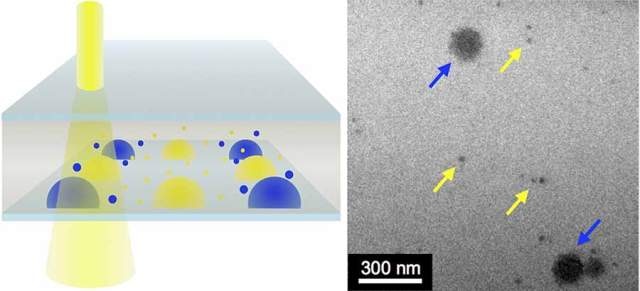May 4 2016
An innovative tool developed by UC San Diego chemists enables researchers to visualize mixing processes or chemical reactions occurring in liquids at the nanoscale.
 By mixing combinations of gold nanoparticles (yellow arrows) with other nanoscale crystals (blue arrows) in the LCTEM (at left), the chemists showed their technique works. Images by Lucas Parent, UC San Diego
By mixing combinations of gold nanoparticles (yellow arrows) with other nanoscale crystals (blue arrows) in the LCTEM (at left), the chemists showed their technique works. Images by Lucas Parent, UC San Diego
Traditionally, researchers have been using transmission electron microscopy (TEM) to view nanoscale structures, but this method can only record static images and requires the samples to be frozen or dried, and placed inside a vacuum chamber for visualization. Consequently, researchers were not able to view ‘nanoscale’ chemical reactions or living processes, such as the contraction and growth within the living cells of small fibers, nanoscale protrusions that are critical in the movement and division of cells, or the changes induced by a chemical process in a liquid.
Being able to look at nanoscale chemical gradients and reactions as they take place is just such a fundamental tool in biology, chemistry and all of material science. With this new tool, we’ll be able to look at the kinetics and dynamics of chemical interactions that we’ve never been able to see before.
Nathan Gianneschi, Professor of Chemistry and Biochemistry, UC San Diego
Gianneschi led the research team, which described this latest development in a paper published on the Microscopy and Microanalysis journal.
As chemists, we could only really analyze the end products or bulk solution changes, or image at low resolution because we could never see events directly occur at the nanoscale.
Nathan Gianneschi, Professor of Chemistry and Biochemistry, UC San Diego
However, with new advancements in Liquid Cell TEM (LCTEM), scientists are now able to record videos of nanoscale objects present in liquids. A drawback of this method is that it lacks the ability to manage the mixing of solutions, a prerequisite when viewing and studying the reaction of two chemicals or the effect of a drug on a living cell.
In order to address this issue, Joseph Patterson, a postdoctoral researcher in Gianneschi laboratory, in collaboration with researchers at Pacific Northwest National Laboratory and SCIENION AG in Germany, has developed a tool and a technique through which researchers can now deposit small amounts of liquid, approximately 50 trillionths of a liter, inside the LCTEM’s viewing area.
With this technique, we can view multiple components mixed together at the nanoscale within liquids, so, for example, one could look at biological materials and perhaps see how they respond to a drug. That was never possible before. The benefits to basic research are huge. We will now be able to directly see the growth at the nanoscale of all kinds of things, like natural fibers or microtubules.
There’s a lot of interest on the part of researchers in understanding how the surfaces of nanoparticles affect chemical reactions or how nanoscale defects on the surfaces of materials develop. We can finally look at the interfaces on nanostructures so that we can optimize the development of new kinds of catalysts, paints and suspensions.
Nathan Gianneschi, Professor of Chemistry and Biochemistry, UC San Diego
Although the tool is yet to be used for viewing nanoscale chemical reactions in a liquid, the UC San Diego team has demonstrated that the method works by mixing a combination of nanoscale crystals and gold nanoparticles suspended in a solution.
What we’ve demonstrated is the proof of concept, but that’s what we’ll be doing next.
Nathan Gianneschi, Professor of Chemistry and Biochemistry, UC San Diego
While the novel tool will not enable scientists to see molecules in solution, Gianneschi explained that scientists would be able to view the effect of chemical reactions occurring on materials that are five billionths of a meter or larger than 5 nm.
We won’t be observing molecules colliding, but we will be able to observe single particles and collections of them, on the nanometer length scale. Observing these kinds of processes has been one of the key challenges in the field of nanoscience.
Nathan Gianneschi, Professor of Chemistry and Biochemistry, UC San Diego
UC San Diego and SCIENION AG have jointly applied for a patent to license the new tool and technique. Other co-authors of the paper include Lucas Parent of UC San Diego; James Evans of Pacific Northwest National Laboratory; Holger Eickhoff, Joshua Cantlon, and Guido Bared of SCIENION AG in Berlin.
The research was funded by grants from the U.S. Air Force Office of Scientific Research and the U.S. Army Research Office.